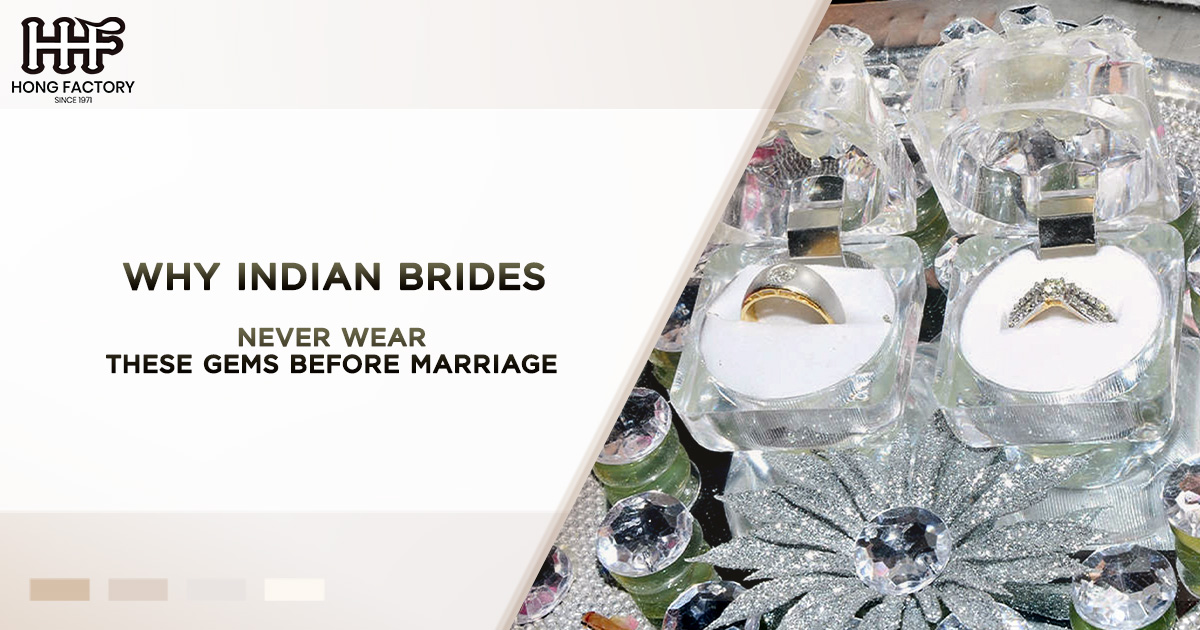
India, a land of diverse cultures and deeply rooted traditions, is renowned for its elaborate wedding ceremonies. Among the many elements that make Indian weddings unique, bridal jewelry holds a position of immense significance. Jewelry is more than mere ornamentation; it is considered a symbol of tradition, prosperity, and blessings for a new chapter in life. However, certain gemstones are deemed “forbidden” for Indian brides to wear before marriage. This article delves into the intriguing world of Indian traditions , exploring the beliefs and marriage customs that shape these pre-wedding jewelry choices.
The Significance of Jewelry in Indian Weddings
Jewelry has been an integral part of Indian culture for centuries. In Indian weddings, each piece of jewelry worn by the bride carries a symbolic meaning. From gold necklaces and bangles to maang tikkas and anklets, every ornament is believed to bring blessings, good luck, and prosperity to the bride in her married life.
However, there is a fascinating aspect to this tradition that often goes unnoticed – the restrictions placed on brides regarding certain gemstones before their marriage. These beliefs, steeped in cultural and spiritual symbolism, are followed with great reverence in many parts of India.
The Cultural Perspective – Why Some Gems Are Forbidden

The idea of “forbidden gems” before marriage is deeply rooted in Indian traditions and cultural superstitions. These beliefs stem from a mix of astrology, mythology, and spiritual customs. Let’s explore some of the key reasons behind this practice –
- Astrological Influences
Indian astrology, or Vedic astrology, plays a significant role in determining what gemstones are suitable for individuals. According to this ancient system, gemstones are associated with specific planets, energies, and cosmic vibrations. Some gemstones, like black pearls or opals, are believed to harbor inauspicious or negative energies that could disrupt the harmony of a bride’s life before marriage.
For instance, black gemstones are often avoided before marriage because they are associated with Saturn (Shani), a planet linked to challenges and obstacles. Wearing such gems is believed to invite unnecessary delays or difficulties in the wedding process or the bride’s future life.
- Symbolism of Purity and New Beginnings
Marriage in Indian culture symbolizes a new beginning, purity, and prosperity. Certain gemstones are considered unsuitable for a bride before marriage as they are believed to carry energies that contradict these ideals. For example
- Opals are often avoided due to their association with bad luck and instability.
- Black pearls or black gemstones are seen as symbols of sorrow or mourning, making them inappropriate for a joyous occasion like a wedding.
Traditionally, brides are encouraged to wear gems like diamonds, rubies, and emeralds, which are seen as auspicious and reflective of positive energy.
Gems Often Avoided by Indian Brides Before Marriage
Here are some of the gemstones that are traditionally avoided by Indian brides before their wedding day
- Opals
Opals are regarded as beautiful yet controversial gemstones in Indian culture. They are often associated with unstable energy and bad luck, especially for unmarried women. Brides are advised to stay away from this stone until after marriage to ensure harmony and stability in their marital life.
- Black Pearls
Black pearls, while stunning, are considered inauspicious for pre-wedding use. They are believed to symbolize sorrow and mourning, which contradict the joyous nature of a wedding. Brides are discouraged from wearing black pearls to avoid inviting any negative energy into their lives.
- Black Onyx or Other Black Stones
Black gemstones, including onyx, are avoided because they are associated with Saturn’s energy. Saturn, in Vedic astrology, represents challenges, delays, and hardships. Wearing black stones before marriage is thought to bring unnecessary obstacles to the bride’s new life.
- Cat’s Eye (Lehsunia)
The cat’s eye gemstone is associated with the shadow planet Ketu in astrology. While it is considered a powerful protective stone for some, it is typically avoided by brides due to its intense energy and potential to attract sudden changes or challenges.
- Yellow Sapphire (Pukhraj) Without Consultation
While yellow sapphire is considered auspicious for married women, it is often worn only on the advice of an astrologer. This gemstone is linked to the planet Jupiter (Guru), and wearing it without proper guidance could lead to unintended consequences, especially for unmarried women.
The Role of Rituals and Marriage Customs
Indian weddings are steeped in rituals and marriage customs , many of which revolve around the bride’s attire and jewelry. These customs are designed to protect the bride from negative influences and ensure a harmonious married life. The avoidance of certain gemstones is often tied to these rituals.
- Energy Cleansing Rituals
Before a bride wears her wedding jewelry, it is often purified through rituals to remove any negative energy. This ensures that the jewelry carries only positive vibes as the bride embarks on her new journey.
- Wedding Jewelry as a Blessing
In many Indian families, bridal jewelry is gifted by parents or elders as a blessing. This jewelry is carefully chosen to include only auspicious gems and metals, reflecting wishes for prosperity, happiness, and longevity.
- Astrological Consultations
Astrology plays a key role in determining the suitability of gemstones for a bride. Families often consult astrologers to ensure that the bride’s jewelry aligns with her birth chart and planetary positions.
Modern Perspectives – Balancing Tradition and Personal Choice
While traditional beliefs about bridal jewelry and forbidden gems continue to hold sway, modern brides are increasingly blending these customs with their personal preferences. For instance
- Some brides may choose to wear black gemstones despite traditional beliefs, viewing them as fashion statements rather than symbols of misfortune.
- Others may consult astrologers to find gemstones that are both auspicious and aesthetically pleasing.
The key is to strike a balance between respecting Indian traditions and embracing individuality. Many jewelers now offer customized bridal sets that incorporate traditional designs with contemporary styles, allowing brides to honor their heritage while expressing their unique personality.
Conclusion
The practice of avoiding certain gemstones before marriage is a fascinating aspect of Indian traditions that reflects the deep cultural and spiritual significance attached to bridal jewelry . Rooted in astrology, symbolism, and marriage customs , these beliefs continue to shape the choices of brides across India.
As modern brides navigate the intersection of tradition and personal expression, the timeless allure of Indian bridal jewelry remains undeniable. Whether guided by spiritual beliefs or personal style, the jewelry a bride wears on her wedding day is a celebration of love, culture, and new beginnings. So, while some gems may remain “forbidden” before marriage, the beauty and symbolism of Indian bridal jewelry will forever shine brightly.










